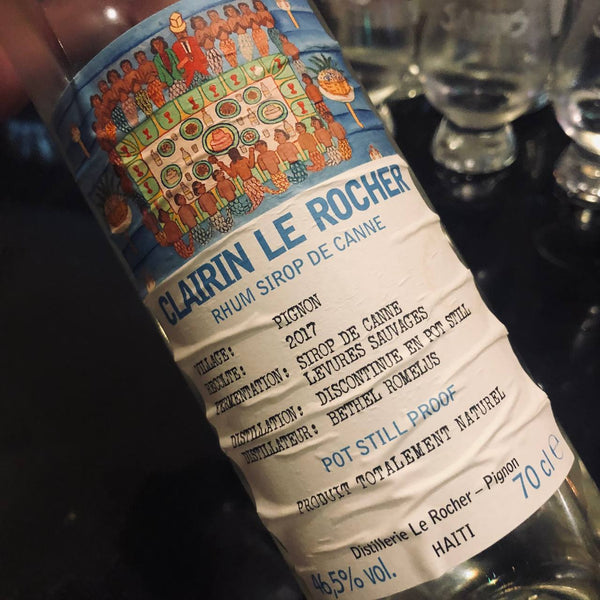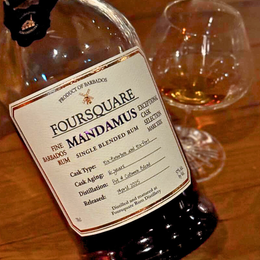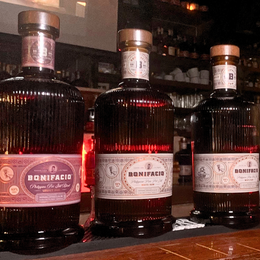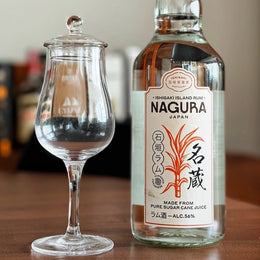Clairin Le Rocher, 2017, Le Rocher Distillery, Pignon, Saint-Raphael, Haiti, 46.5% ABV, La Maison & Velier

Ah tricky one! This Clairin, launched in 2017, breaks the trend – it isn’t made by a person named Le Rocher. Instead, it is crafted by one particularly spirited and spiritual individual named Bethel Romelus. Le Rocher actually means “The Rock”, and is named after the bible verse Matthew 7: 24-27, where Jesus expounds on a parable emphasizing the need to build a strong foundation; to build a house on a solid rock, rather than on sand. The distillery is located in the village of Pignon, not too far from where Michel Sajous produces his juice.
One thing to note about Clairin Le Rocher is that unlike the first three, it is made using sugar cane syrup from three varieties of sugarcane, procured from the town of St Michel, which as mentioned above under Clairin Sajous, is known for their cane syrup. The cane syrup is then run through a discontinuous pot still and then bottled, in similar fashion to the other Clairins.
Another thing that is quite unique about the Le Rocher is Bethel’s use of dunder, where a third of the previous round of fermentation’s material is carried forward to each subsequent batch. It is a process that would instantly remind rum lovers of the Jamaicans.


(Image Source: Excellence Rhum)
Color: Is it possible to be more transparent than water? Clear, colorless spirit.

Wait, they're not the same? (Image Source: Yummy, Instructables)
Nose: Noticeably less bright and acute; if the other Clairins presented the typical newmake kerosene scent, this one’s diesel. It’s the same synthetic, industrial, plasticky, Play-Doh scent but deeper, less aggressive and even confectionary. No less pungent though. This could be identified as Tutti-Frutti flavored ice cream.

A very rich, umami flavor on the base of the nose of bouillon cubes, morels and kombu. (Image Source: Fine Cooking, Spruce Eats, Mara Seaweed)
This interestingly allows other scents through, such as bouillon cubes, chicken consommé, dashi – it’s at once salty, rich and oily. There are also more umami notes like black truffles, morels, kombu. The grassy notes still exist but far more laidback.
Perhaps the most complex of the lot of Clairins.

Similar to the Sajous, a chockful of flavors jump right at you, with funky overripe bananas, confectionary candy corn, fresh laundry and a spritz of sea spray. (Image Source: King Arthur Baking, Vox, Good Housekeeping, Green Queen)
Palate: The attack is really more of a laidback greeting, albeit a crowded one. It is creamy and silky as with the other Clairins. As with the Sajous, here comes a wave of different flavors – high notes ranging from funky hogo, tropical fruits, candy corn, to lighter florals and fresh laundry, and then sea spray and dill, rosemary and lemongrass herbs, pickled cucumbers, and lastly earthier notes like mushrooms and soil.

This leads on to other flavors such as a brighter lemongrass, a more acidic and tart pickled cucumbers, and an earthy scoop of fresh soil. (Image Source: Linsfood, Cookie and Kate, Nature Connection Guide)
It is at once, funky, fruity, almost artificially sweet, floral, salty, acidic, herbaceous, umami and earthy. There’s every note you could look for on the spectrum, but what do you even make of it?
As with the nose, it’s probably the most complex. It somewhat resembles the Sajous, if amped up a couple of notches. Everything is just more intense here. Yet, there is little definition to each note, and they all choke their way through at the same time, leaving not too much space for savoring.

Greek yogurt, a spoonful of honey and a sprig of rosemary on the finish. (Image Source: Lemon and Olives, Edible Communities)
Finish: Long drawn out, with a taste and texture that somehow reminds me of Greek yogurt with the slightest hint of honey. Toss in a twig of rosemary for good measure.
My Rating |
🏋️♀️This one's very reminiscent of the Sajous, could be because they source their sugarcane material from the same town, although one's juice and one's made of syrup. It's an amped up version of the Sajous - lots of flavors and complexity but falls short on the same flaws of the flavors being difficult to disentangle. |
Kanpai!

@111hotpot







